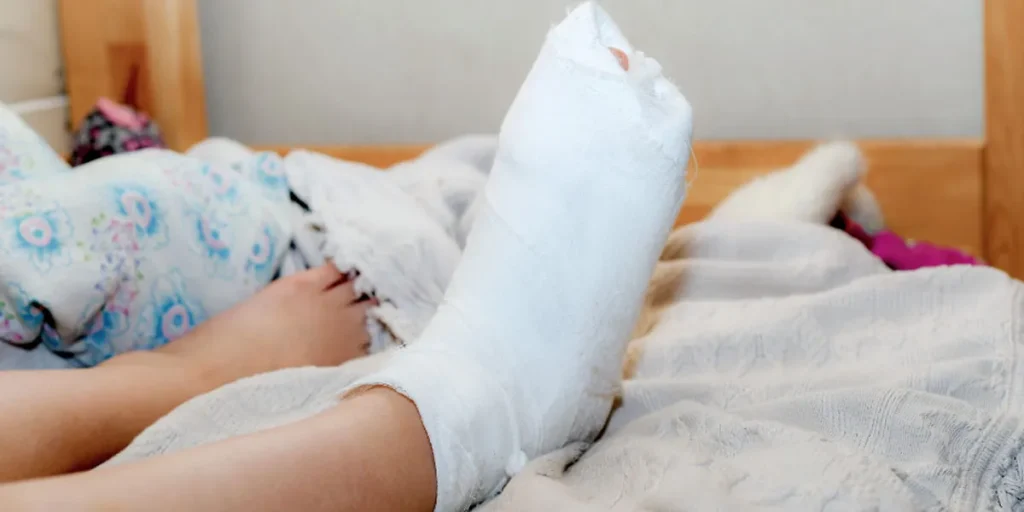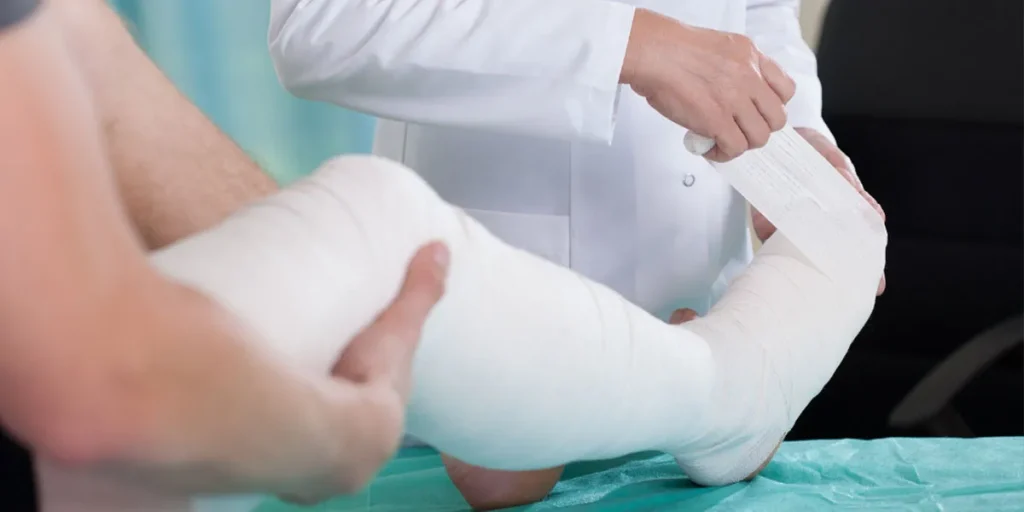A leg cast typically weighs between 2 to 5 pounds (0.9 to 2.3 kilograms). The weight can vary depending on the size and materials used.
Dealing with a broken leg or injury often leads to the necessity of wearing a cast. This crucial medical device supports and stabilizes the affected area to ensure proper healing.
The exact weight of a leg cast depends on the length of the cast covering the limb and the type of cast material—plaster of Paris or fiberglass.
Plaster casts tend to be heavier, though they offer a cost-effective solution; fiberglass options are lighter and more durable, making them a popular choice for many patients.
Understanding the weight of these casts is important for those who may need to adjust their daily activities and mobility during their recovery period.
Choosing the right type of cast is a decision often made by healthcare professionals based on the specific needs of the injury and patient preferences.
Leg Cast Essentials

Dealing with a broken leg is tough, but understanding leg cast essentials helps ease the journey. Knowing what to expect can be a beacon of comfort.
Material Matters
The weight of a leg cast depends on its material. Plaster of Paris is the classic choice. It’s sturdy but heavier.
Fiberglass casts, on the other hand, are lighter and more popular today. They allow skin to breathe and are lighter on your leg.
- Plaster casts: Weighs more, less water-resistant
- Fiberglass casts: Lighter, durable, and comes in colors
Standard Sizes And Variations
Leg casts come in various sizes. A full-leg cast is heavier than a below-the-knee cast.
| Cast Type | Approximate Weight |
|---|---|
| Full-Leg Cast | 3.5 to 10 pounds (1.6 to 4.5 kg) |
| Below-the-Knee Cast | 2 to 7 pounds (0.9 to 3.2 kg) |
Age and height of the person can change the weight too. Children’s casts are lighter than adult ones.
Weight Factors
Understanding the weight factors of a leg cast is crucial. It affects comfort and mobility. This section explores what makes up the weight of a leg cast.
Material Density
Not all casts are the same. Materials play a big role in weight. Some common materials include:
- Plaster: Traditional but heavy
- Fiberglass: Lighter and more durable
- Hybrid: Mix of materials for strength and reduced weight
Remember, fiberglass casts tend to be the lightest option.
Cast Length And Thickness
The size of the cast affects its weight. Consider these factors:
| Cast Size | Weight Impact |
|---|---|
| Full Leg | Heavier, more material |
| Short Leg | Lighter, less material |
| Thickness | Thicker casts add weight |
A thicker cast, used for more severe injuries, will weigh more.
Add-ons Impact
Cast add-ons contribute to the total weight. Some add-ons include:
- Walking heels
- Waterproof liners
- Padding
- Decorative covers
Each add-on adds a small amount of weight. Padded casts are more comfortable but heavier.
Average Weights

Curious about the weight of that cast? Here’s a quick dive into how much you might expect your temporary plaster companion to tip the scales at.
Casts come in various sizes and materials, influencing their weight. Let’s explore the average weights for both pediatric and adult casts, providing comparative insights along the way.
Pediatric Casts
Pediatric Casts
Smaller limbs mean lighter casts. Children’s casts are more compact, with less material used. This results in a significantly lighter cast.
On average, pediatric arm casts weigh between 1 to 2 pounds (0.45 to 0.9 kg), whereas leg casts can weigh from 2 to 4 pounds (0.9 to 1.8 kg).
Adult Casts
Adult Casts
As we grow, so does our need for a sturdier cast. Adult casts are larger and require more material.
A typical adult arm cast may weigh around 3 to 5 pounds (1.4 to 2.3 kg), while leg casts can vary from 5 to 10 pounds (2.3 to 4.5 kg), depending on the person’s size and the cast material.
Comparative Insights
Comparing casts, material is a key factor. Plaster casts are heavier, yet they offer a snug fit. Fiberglass, on the other hand, is lighter and more durable. To illustrate, here’s a comparison:
| Cast Type | Material | Average Weight |
|---|---|---|
| Short Arm Cast | Plaster | 3-4 lbs |
| Short Arm Cast | Fiberglass | 1-2 lbs |
| Long Leg Cast | Plaster | 10 lbs |
| Long Leg Cast | Fiberglass | 3-5 lbs |
Physical Implications
When you break a leg, the doctor might put it in a cast. A leg cast helps your bone heal. But casts can be heavy.
They make moving and walking harder. Your muscles might get weaker too. Let’s talk about how this weight affects your body.
Mobility Considerations
A heavy cast changes how you move. You will need to learn new ways to walk. Your balance might be off. You may need crutches or a wheelchair.
These tools help you move without hurting your leg more. Think about your home and if it’s easy to move around with a cast.
- Take shorter steps to keep balance.
- Move slowly to avoid falls.
- Plan your path to make sure it’s clear.
Muscle Atrophy Concerns
Not using muscles leads to muscle atrophy. This means muscles get smaller and weaker. A heavy cast means your leg muscles are not working much.
After the cast comes off, you may need exercises to get strong again.
| Timeframe | Muscle Loss | Recovery Action |
|---|---|---|
| 1-2 weeks | Minimal loss | Light exercises |
| 3-6 weeks | Moderate loss | Regular physiotherapy |
| 7+ weeks | Significant loss | Intensive rehabilitation |
Start with simple stretches. Then do exercises that your doctor says are okay. This will help your muscles become strong again. Be patient, regaining muscle takes time.
Living With A Leg Cast
Imagine walking with an extra weight strapped to your leg. That’s daily life with a leg cast. Leg casts vary in weight, but they can feel like carrying a heavy boot.
Embracing a new lifestyle is key to coping.
Daily Activities And Adjustments
Adapting your routine is essential when you have a leg cast. Tasks that were simple pre-cast might now need some creative problem-solving. Here’s a snapshot of what to expect:
- Getting dressed: Loose clothing and shoes with good grip are your new best friends.
- Bathing: Cast covers keep your cast dry and make showering possible.
- Moving around: Crutches, walkers, or wheelchairs will become crucial mobility aids.
- Driving: If the cast is on your right leg, you might need to pause driving until recovery.
- Accessibility: Ramps and handrails can make your home easier to navigate.
Small adjustments lead to big improvements in comfort and independence.
Exercise And Rehabilitation
Maintaining strength and flexibility is vital for a speedy recovery. Even with a cast, certain exercises are still doable:
| Part of Body | Exercise | Benefit |
|---|---|---|
| Upper body | Arm lifts with light weights | Increases strength |
| Core | Seated twists | Improves balance |
| Non-casted leg | Leg lifts and stretches | Keeps muscles active |
Always consult your doctor or physiotherapist before starting new exercises. They can tailor a plan to suit your individual needs. Your cast doesn’t have to mean a full stop to physical activity.
Beyond The Weighing Scale
Beyond the Weighing Scale explores not just how much a leg cast weighs but also the strides in technology that make them more comfortable and effective for patients.
The weight of a leg cast can vary, but it’s not the only factor to consider. This section delves into exciting advancements and future trends in cast technology and orthopedic treatments.
Innovation In Cast Technology
Revolutionary materials and designs are changing the game in cast technology.
Traditional plaster casts are giving way to lightweight composite materials that provide increased comfort and mobility.
These modern casts can weigh significantly less than their predecessors, often reducing the physical burden on the wearer. Key innovations include:
- Waterproof lining allows for showering without a cast cover.
- Breathability prevents skin irritations and improves hygiene.
- Customizable 3D-printed casts offer tailored support and fit.
Future Trends In Orthopedic Treatments
Anticipation for the next generation of orthopedic solutions is high, with a focus on enhancing patient quality of life.
Upcoming trends show a shift towards non-invasive and patient-centric treatments. Highlights of these future trends include:
- Biodegradable materials reducing environmental impact.
- Smart casts with embedded sensors to monitor healing progress.
- Augmented reality applications for precise, personalized treatment plans.
FAQs About the Weight of a Leg Cast
What Is The Average Weight Of A Leg Cast?
Leg casts can vary in weight but typically range from 2 to 5 pounds.
The exact weight depends on the size of the cast and the materials used. For instance, fiberglass casts are lighter than plaster ones.
Can A Leg Cast Weight Impact Recovery?
While a leg cast’s weight is generally manageable, it can impact mobility and comfort.
Proper elevation and movement within restrictions can help offset these issues and aid in recovery.
How To Manage Daily Activities With A Leg Cast?
Managing daily activities with a leg cast involves planning and assistance.
Use crutches or a wheelchair for mobility, keep the cast dry, and elevate your leg to reduce swelling and discomfort.
Does Cast Weight Differ For Kids And Adults?
Yes, cast weight does differ between kids and adults. Pediatric casts are smaller and lighter, as they are designed for smaller limbs.
Adult casts are larger and can weigh more due to the size and material.
Conclusion
Understanding the weight of a leg cast is crucial for both patients and caregivers. It eases mobility planning and comfort considerations.
On average, expect a cast to weigh between two to five pounds. Keep this in mind next time you or a loved one needs one.
Stay informed for a smoother recovery journey.
Resources:
https://www.urmc.rochester.edu/encyclopedia/content.aspx?contenttypeid=90&contentid=P02750
https://www.cclhd.health.nsw.gov.au/wp-content/uploads/Leg-cast-care-and-exercises.pdf
